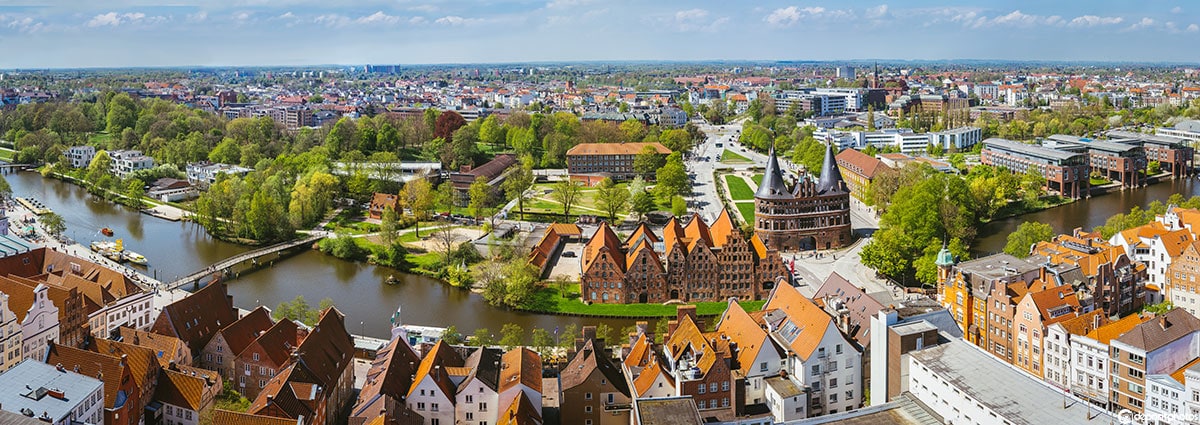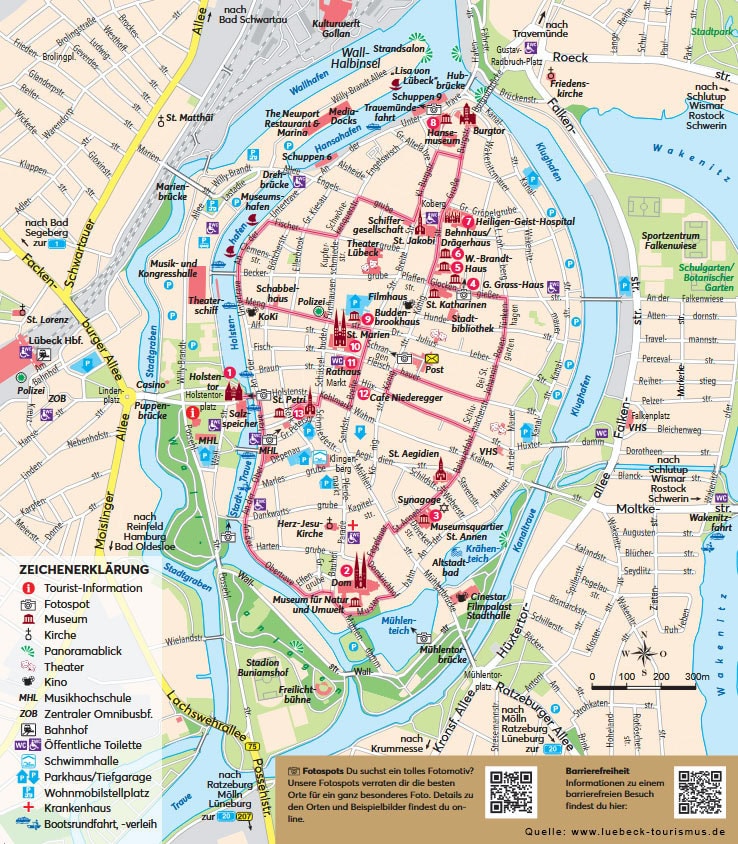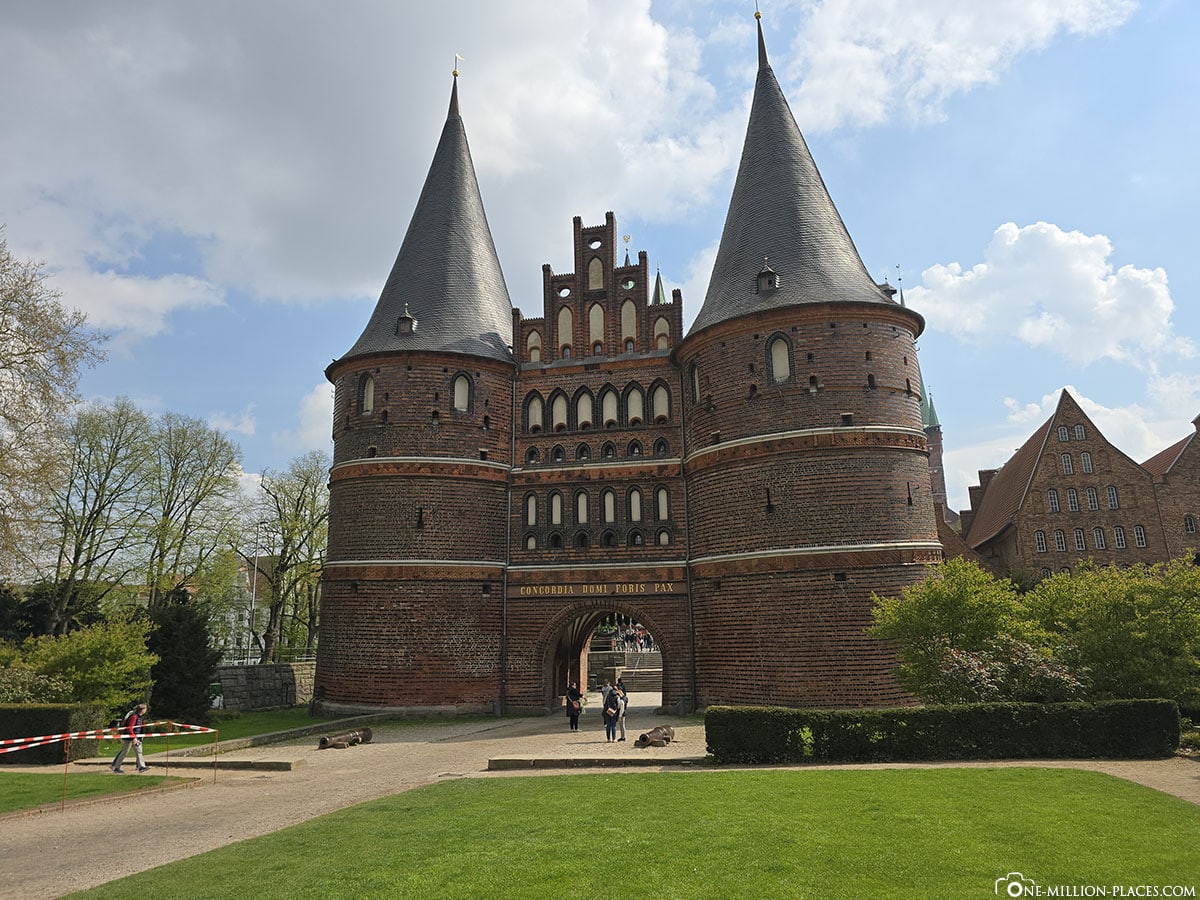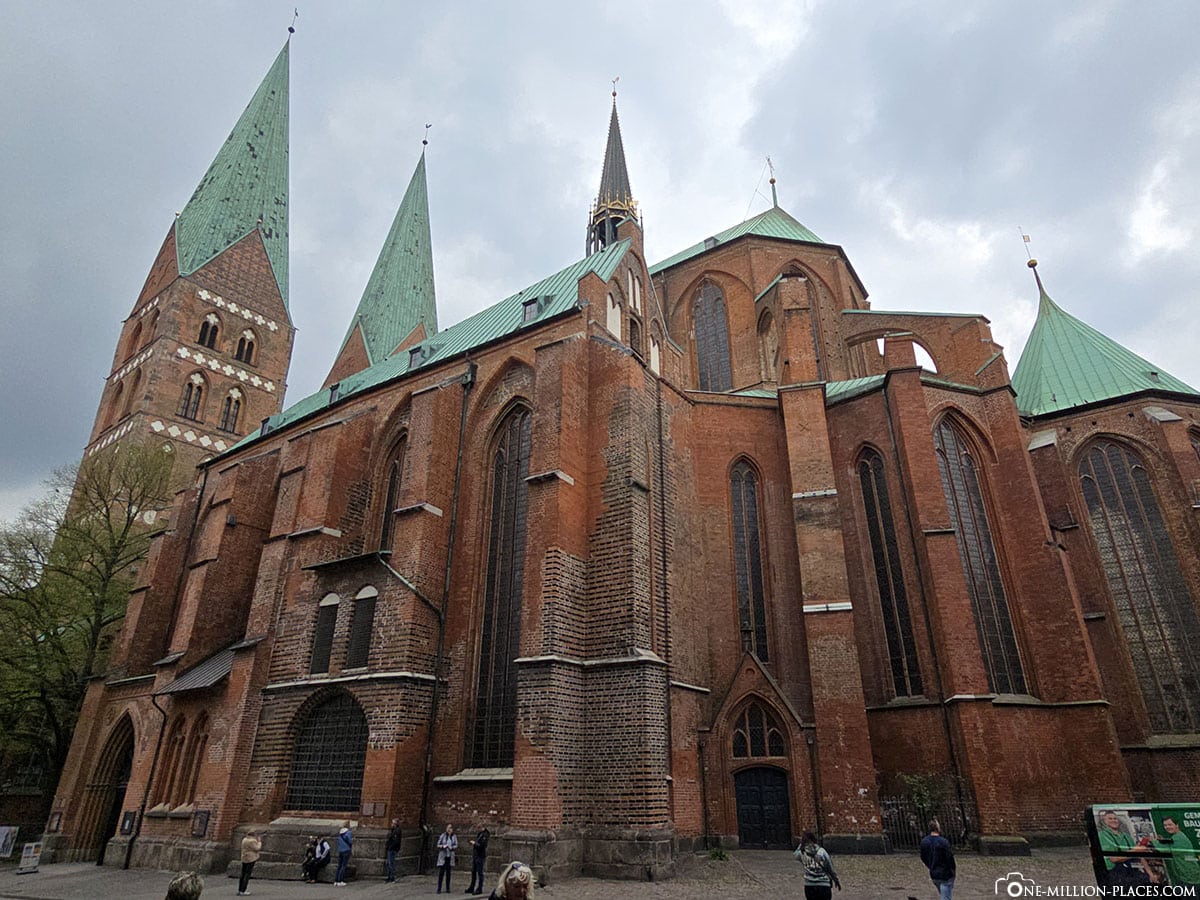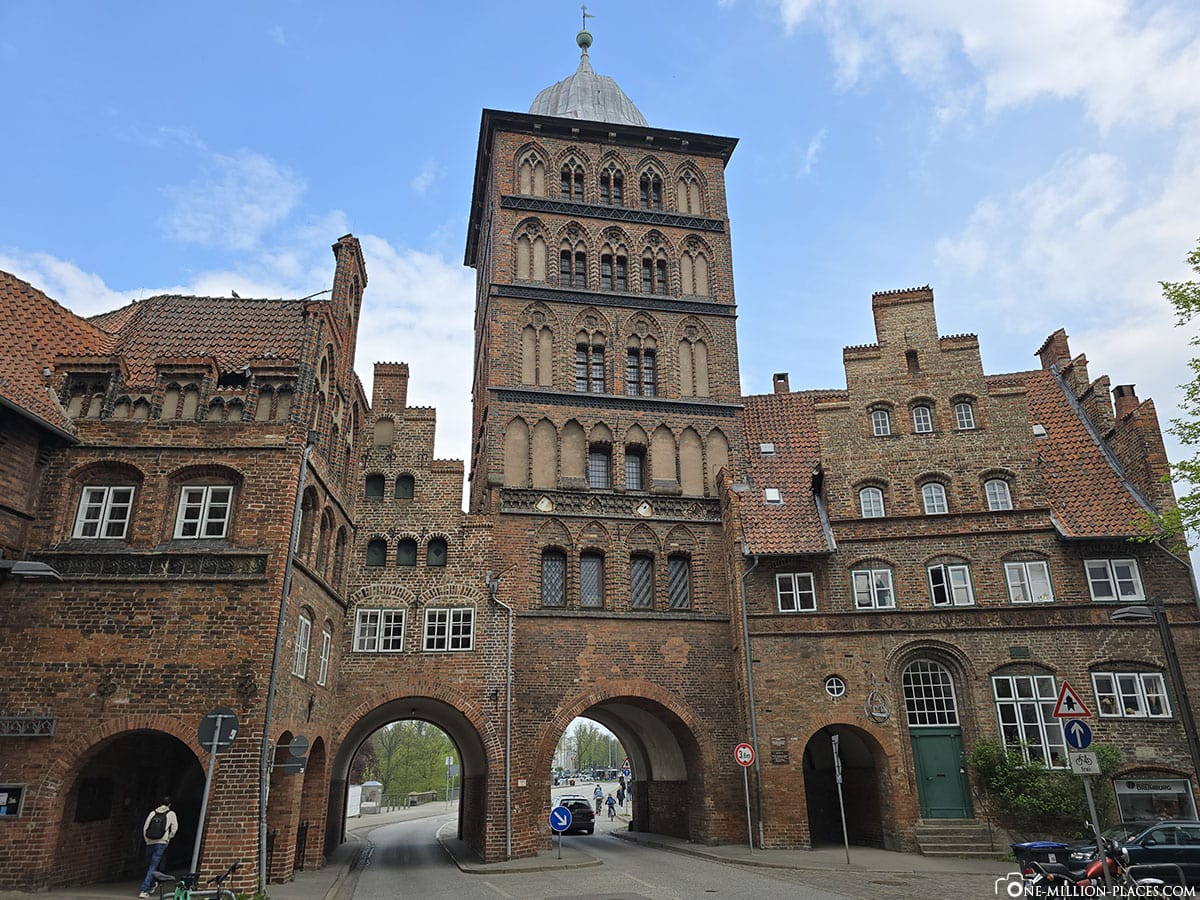The Hanseatic city of Lübeck had long been on our list of cities in Germany that we wanted to explore. And we weren’t even aware that the old town of Lübeck had even been awarded UNESCO World Heritage status. We were all the more looking forward to our visit and explored the most important sights and photo spots in the old town in one day.

Table of contents
Interesting facts about Lübeck
Lübeck is located in the north of Germany in the federal state of Schleswig-Holstein, not far from the Baltic Sea and around 65 kilometers northeast of Hamburg. With around 217,000 inhabitants (as of 2024), Lübeck is the largest city in the state after Kiel. The city stretches along the Trave, a river that flows directly into the Bay of Lübeck. Its geographical location made Lübeck an important trading center early on, which is still reflected in its maritime character today. The historic old town lies on an island and is surrounded by waterways – a unique cityscape that is particularly characterized by its many bridges and alleyways.
Lübeck was founded in 1143 and quickly developed into the “Queen of the Hanseatic League” – a medieval trading alliance that connected large parts of northern Europe. The heyday of the Hanseatic League in 13. and The 14th century had a lasting impact on the cityscape. Today, the old town with over 1,000 listed buildings is a UNESCO World Heritage Site. Among the most famous sights are the Holsten Gate – one of the city’s landmarks -, the mighty St. Mary’s Church, the historic town hall, the Holy Spirit Hospital and the Buddenbrook House, which commemorates the Mann family of writers. Lübeck marzipan, world-famous thanks to the traditional Niederegger company, is also inextricably linked with the city.
UNESCO World Heritage status
There are currently (as of 2025) 54 UNESCO World Heritage Sites in Germany, including 51 World Cultural Heritage Sites and three World Natural Heritage Sites.
The Hanseatic city of Lübeck was the first city in Northern Europe to be included on the UNESCO World Heritage List in 1987 due to its unique historic old town. The decisive factor for the award was the impressive medieval townscape with its well-preserved buildings from the Brick Gothic period, such as the famous Holsten Gate, St. Mary’s Church and the town hall. Lübeck played a central role in medieval trade and developed into a cultural, political and economic center of Northern Europe. The UNESCO recognized Lübeck’s outstanding importance for the history and development of the Hanseatic League and the exceptional state of preservation of its historic buildings.
A city map of Lübeck
The following city map of Lübeck shows the most important sights and photo spots that we visited in one day. This city map can be downloaded here free of charge as a pdf version.
The sights of Lübeck
We parked our car in the large “parking lot on the Trave” (location in Google Maps). A day ticket costs EUR 6 and from here it is only a few meters to the old town. We took around 6 hours to explore Lübeck’s most famous sights and photo spots on foot and on our own.
Holsten Gate
It is THE FOTOMOTIVE in Lübeck and certainly one of the most famous photo spots in Germany: the Holsten Gate 🙂
The Holsten Gate is probably Lübeck’s best-known landmark and is one of the most important medieval city gates in Germany. Built between 1464 and 1478, it was part of the once imposing city fortifications and served both defensive and representational purposes. With its two round brick towers, pointed roof and richly decorated façade in the brick Gothic style, the gate still conveys an impression of the power and self-confidence of the former Hanseatic city. The Latin inscription “Concordia domi foris pax” is emblazoned in gold letters above the entrance, meaning “Concord within, peace without”. Originally, the Holsten Gate was just one of four city gates, but it is the only one to have survived the centuries virtually unscathed and has long since become a symbol of Lübeck.
Inside the Holsten Gate there is now a museum that vividly illustrates the history of the Hanseatic League and the importance of the city as a trading metropolis. Historical armor, models of merchant ships and interactive stations bring the past to life – an exciting place to discover, especially for families with children. The building itself is also worth seeing: the slightly outward-sloping towers and the vaulted rooms provide an authentic insight into medieval construction and defense technology.
Salt warehouses
The salt warehouses in Lübeck are an impressive relic of the Hanseatic era and are among the most striking buildings in the city. Located right next to the Holsten Gate on the banks of the River Trave, the six gabled brick buildings date from the 16th to 18th centuries and were once used to store salt – one of the Hanseatic League’s most important trading goods. The “white gold” was mainly brought in from Lüneburg and exported from Lübeck to the Baltic region, where it was essential for preserving fish. Today, the salt warehouses are a popular photo motif and a reminder of Lübeck’s great economic importance in the medieval trading world.
Marketplace & Town Hall
The market square with the adjoining town hall is one of the city’s most impressive historical ensembles and has been its political and social center for centuries. Since the 12th century, the market square has been the center of urban life, where markets, festivals and events are still held regularly today. Cobblestones, ornate facades and the view of the towers of St. Mary’s Church give the town a special atmosphere.
Lübeck Town Hall is one of the oldest and most beautiful town halls in Germany. Construction began as early as 1230 and since then it has been extended and altered several times, resulting in a fascinating mix of Gothic, Renaissance and Baroque styles. The ornately decorated gables, the filigree turrets and the black brick façades with their striking blinds are particularly striking – a prime example of North German Brick Gothic.
St. Mary’s Church
St. Mary’s Church is a masterpiece of North German brick Gothic architecture and is considered the mother church of many other Gothic churches in the Baltic region. With its length of over 125 meters, the two 125-meter-high towers and the imposing interior, it set new standards in the 13. and Its 14th century architecture set standards far beyond the city limits. The huge vault, which spans one of the highest brick-built naves in the world, is particularly impressive. A silent witness to the destruction during the Second World War are the broken bells, which fell during a bombing raid in 1942 and still lie on the floor of the south tower as a memorial.
Holy Spirit Hospital
The Holy Spirit Hospital is one of the oldest social institutions in Europe and is an impressive testimony to medieval welfare work. It was founded in 1286 and served as a hospital for poor, old and sick people for centuries. The elongated brick building with its characteristic façade, pointed towers and small church inside still conveys a vivid impression of the charitable spirit of the Hanseatic era. Particularly worth seeing is the large hall with the small wooden bunks in which the inhabitants used to live – a fascinating insight into everyday life in the Middle Ages.
Castle gate
Alongside the famous Holsten Gate, the Castle Gate is Lübeck’s second surviving city gate and an important testimony to the city’s medieval fortifications. It was built in 1444 in the brick Gothic style and marked the northern entrance to the old town. In contrast to the massive, imposing Holsten Gate, the castle gate appears somewhat simpler, but its high tower with its pointed helmet and the small decorative gables give it an impressive silhouette. Originally, the gate was part of a larger fortification with moats, walls and additional towers. Today, it forms the transition between the old town and the St. Gertrud district and is a popular photo stop for visitors who want to walk in the footsteps of the medieval city walls.
Cathedral
Lübeck Cathedral is one of the oldest sacred buildings in the city and an impressive example of North German brick architecture. Begun in 1173 under Henry the Lion, the cathedral, originally built in Romanesque style, was later remodeled in Gothic style and dominates the southern silhouette of the old town with its two striking towers. Severely damaged in the Second World War, the cathedral was restored at great expense and now houses important works of art, including the monumental triumphal crosses by Bernt Notke.
Other sights in the old town
On our tour through the old town, we discovered many more sights and beautiful photo spots. These include the Willy Brandt House, the birthplace of the Nobel Peace Prize winner, which today houses an interactive exhibition on the political work of Willy Brandt and contemporary German history. The Katharinenkirche, Lübeck’s only surviving monastery church, is an architectural gem. The painting “The Raising of Lazarus” by Jacopo Tintoretto, which can be admired inside the church, is particularly impressive.
The Hotel Anno 1216, a stylish boutique hotel in the heart of the old town, is also a beautiful photo opportunity. The building is one of the oldest brick buildings in the city, first mentioned in a document in 1305. Café Niederegger is a paradise for those with a sweet tooth. Here you can not only taste the world-famous Lübeck marzipan, but also marvel at life-size figures made from the sweet mass in the Marzipan Museum and learn more about the history of this delicacy. Finally, the Rossmühle, built in 1750, originally served as a corn mill and warehouse. Today it is a listed residential building and a silent witness to Lübeck’s industrial past.
All in all, we really enjoyed our visit to Lübeck 🙂

